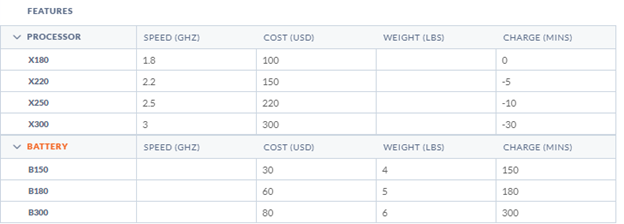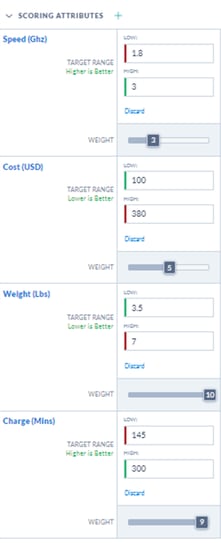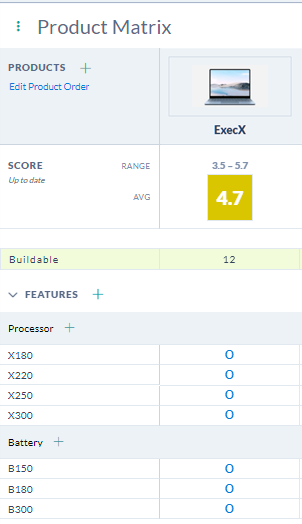Here's how product scoring works and why you really want to know all about it.
Deciding on what products and features to offer to the market requires an understanding of your business and customer needs. At times, you need to strike a balance between multiple factors to come up with a product that best meets those needs. However, the factors requiring consideration are often competing with each other.
Consider a laptop. Higher processing power means shorter battery life and higher cost. Customers will buy a laptop with a higher processing speed up to a limit, depending on price and time between charges. So, how do you find that balance?
With a weighted product score, you can measure how well a product meets a set of limitations, or “targets.” Typically, calculating a weighted score quickly becomes costly and complex, as the number of features and targets increases. That is why we automated the weighted product score calculation – to allow you to better analyze your products for the market.
Scoring your product as a measure of customer fit
You can view a product as a collection of standard or optional features. Features are characteristics of your product that customers understand and value. Customers can configure a variant of the product to their liking by selecting various options within the targets you define.
Each product variant can have specifications – for example cost, weight, and length – depending on the product. Knowing your customers’ preferences, you can score each variant to see how close the specifications are to meeting their needs. The score is a scale from one to 10, where 10 shows that the product variant specifications meet or exceed the customer preferences, and zero means that none of the specifications meet your customers’ preferences. Any score in-between indicates that your product partially meets the needs of your customer base.
Each product can be configured in multiple ways resulting in one or more variants. The average score across all variants can show you how well the product as a whole meets your customers’ needs.
Let's go through an example. Imagine your company manufactures a line of laptops called ExecX, tailored for executives and managers that are on the road and frequently travel for work. You and your team are in charge of defining and planning a line of laptops, and you would like to know what configurations of processors and batteries best meet your customers’ needs. The following are the processors and batteries available for you to offer on your laptop, and their specifications.

You can combine these features to build different laptops with different specifications. For example, a laptop with an X250 processor and B300 battery will have a variant with the following specifications:
Total Cost = 220 + 80 or 300 USD
Speed = 2.5 Ghz
Weight = 6 pounds
Time between charges = 300 - 30 or 270 minutes
Setting customer preferences and constraints
Based on your study, you know that your customers need lightweight laptops that can stay charged for long periods. As it is configured in the screen below, you determine that your customers would rarely consider a laptop that lasts less than 2.25 hours (145 minutes) between charges and are indifferent if it lasts for 300 minutes or more between charges. You also determine that the weight of the laptop should be between 3.5 and 7 pounds.
While weight and time between charges are the most important decision factors when it comes to customer considerations, you also realize that the laptops should be built within a specific cost and processing speed limit in order to stay competitive. To reflect this, you give laptop weight and time between charges a score weight of 9 and 10 (out of 10) while giving speed and cost a score weight of 3 and 5, respectively.
The following screenshot shows the summary of values that represent your customers’ preferences.

Defining and analyzing your laptop product
You start with making all the batteries and processors above available for your customers to mix and match. As you can see in the screenshot below, customers can build the laptop with a choice of 4 processors, and 3 batteries, this equals 12 different buildable product variants. The variants score in a range from 3.5 to 5.7 depending on the processor and battery chosen. The average score for all of the variants is a score of 4.7 out of 10.

Some things to keep in mind when using product scoring
- What data can I use for scoring?
- Any numerical attribute / specification dataset. Gocious allows you to use up to 20 different datasets for generating a product score.
- Where does the data need to be?
- The score is calculated using product attributes. If you have data held against the features that you want to use as part of the score then you can also associate the attribute with the product and assign the product value by calculation of the feature(s) that contribute to the product value.
- Is there a difference between the score shown on the product matrix and the score shown on a competition matrix?
- The score on a product matrix is calculated from the score settings against the product as defined on the scoring tab in a product line.
- The score on a competition matrix is defined by the score criteria of the benchmark product. When creating a competitive product you are required to select a benchmark product, this products score criteria is what will be used for generating product score on competition products in the matrix.
